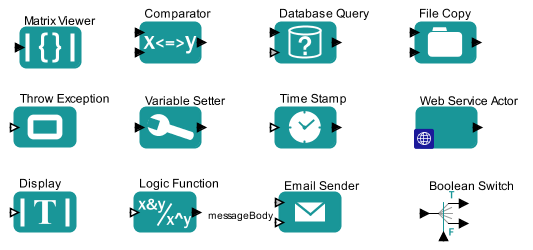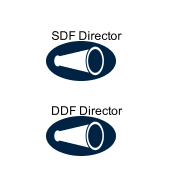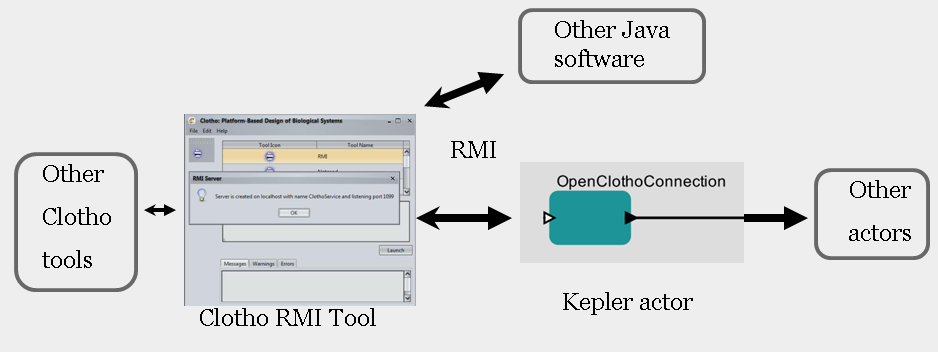Team:Berkeley Software/KeplerTutorial
From 2009.igem.org
Thien.nguyen (Talk | contribs) m |
Thien.nguyen (Talk | contribs) |
||
| Line 12: | Line 12: | ||
|content= | |content= | ||
| - | |||
==Components== | ==Components== | ||
In Kepler, a workflow is built from a collection of process steps that run under the control of a supervisor system.<br> | In Kepler, a workflow is built from a collection of process steps that run under the control of a supervisor system.<br> | ||
Those separate steps are called "actors", they are represented as square icons but inside them are codes to define what to run in a step. A step can be an input/output operation, a computational function, or even another workflow. These actors are supervised by the "director", which keep track of when to run each actor.<br> | Those separate steps are called "actors", they are represented as square icons but inside them are codes to define what to run in a step. A step can be an input/output operation, a computational function, or even another workflow. These actors are supervised by the "director", which keep track of when to run each actor.<br> | ||
| - | [[Image:BerkeleySoftware_KeplerActorList.png|Some actors]] | + | [[Image:BerkeleySoftware_KeplerActorList.png|Some actors]] |
| + | [[Image:BerkeleySoftware_KeplerDirectors.png|Common directors]] | ||
| + | |||
| - | Kepler comes with a library of available actors for many tasks, and user can always write their custom actors and share. | + | Kepler comes with a library of available actors for many tasks, and user can always write their custom actors and share. |
The online manuals provide details instruction of installing and making workflows: [https://kepler-project.org/users/documentation Kepler Documentation]<br> | The online manuals provide details instruction of installing and making workflows: [https://kepler-project.org/users/documentation Kepler Documentation]<br> | ||
Revision as of 08:46, 19 October 2009
{{{video}}}
Kepler Tutorial
Contents |
Introduction
Kepler design environment helps scientists design models and analysis across a broad range of scientific and engineering disciplines.Kepler Project Website This summer we introduced Kepler into synthetic biology by building a set of new Kepler actors for assembly automation and Clotho connection.
Components
In Kepler, a workflow is built from a collection of process steps that run under the control of a supervisor system.
Those separate steps are called "actors", they are represented as square icons but inside them are codes to define what to run in a step. A step can be an input/output operation, a computational function, or even another workflow. These actors are supervised by the "director", which keep track of when to run each actor.


Kepler comes with a library of available actors for many tasks, and user can always write their custom actors and share.
The online manuals provide details instruction of installing and making workflows: Kepler Documentation
Assembly Workflows

As described in the Kepler project page, this workflow get assembly information from Clotho's Algorithm Manager, and output files for the liquid handling robot and human instructions.
Actor list
A. OpenClothoConnection: connect Kepler to Clotho with RMI Tool running. If succeeds, this actor output the connection with Clotho RMI methods so the next actors can use.
B. GetAssemblyGraph & GetString: get data from Clotho, such as the algorithm graph or some debugging string. These actors output either genetic Object data or special structure such as the assembly information
C. GraphProcessing: process the assembly information, check & prepare data for further options
D. DialogOption: antibiotic choices, either at runtime or user provides a choice in the parameter before workflow runs
E. AutomationScheduler
F. Constant: Input for the stage number. This is only a constant number, easy for future modification such as putting an array here for multiple stages in one run
G. OneStageProcessing: Making the files from the assembly graph and the choices of stage and antibiotic
H. Display actors: use to display information, such as finish getting data and the names of created files
Clotho Connection
One of the key challenge for biology tool development is how to effectively share and cooperate. This year we strengthen the possibility of connection between multiple software. In particular, the Clotho platform from last year and Kepler can connect and send data through the remore interface with Java RMI. This RMI connection will guarantee Clotho and Kepler to talk to any Java software that import the same interface.

In assembly workflow, we made actor that open a Clotho RMI connection and actors that read data from Clotho tools. These actors supports genetic data objects and has parameters for tool name and object fields, thus they will work with any future Clotho tools, as long as those tools support Clotho Data API methods.

This is the configuration of the Kepler actor GetString. This actor can read data from tools in Clotho and send out a String object to output ports. In the image, we want to read data from the tool AlgorithmManager, if there are multiple data fields, we can further specify what data we want with the other two parameters.
 "
"